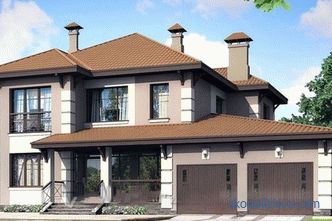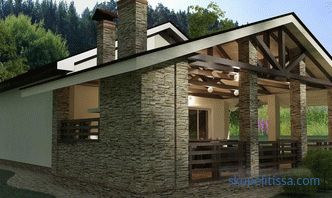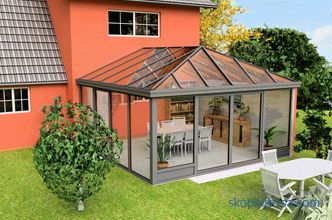Original products of well-known brands provide effective protection of the house from cold and precipitation. The article tells about Izover for the roof - a popular thermal insulation material with a wide range of uses. The proposed material contains information on the composition, application and varieties of insulation Izover for roof and attic. You will learn about the pros and cons, the benefits and average prices for thermal insulation "Warm Roof".
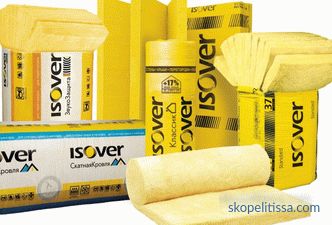
Composition and field of application of the material
Roof erection is a crucial stage, largely determines the comfort and safety of living in the house. In order for the structure to properly perform its protective function, it is necessary to adhere to the installation technology during construction. Also important is the composition of the roofing pie, which includes insulation. Competent choice of heat insulator will help to significantly reduce heat loss, and, therefore, reduce future costs for heating the house.
The modern market offers a wide range of heaters with a different set of qualities, but with one similar parameter - low thermal conductivity. Among heaters, Izover "Warm Roof" is a popular material, whose field of application covers all types of buildings, including public buildings (hospitals and kindergartens), residential buildings and country cottages.
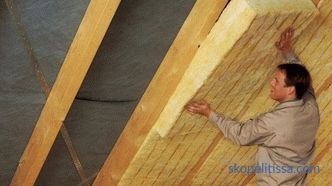
Izover is an advanced type of mineral wool made of glass or basalt fibers. The materials of the group include recycled natural components: mountain basalt rocks, quartz sand or glass breakage. Recommended scope - pitched roofs and attic. It is allowed to use for thermal insulation of vertical walls (external and internal), on the floors along logs and ceilings.
Advantages and disadvantages
The structure of the material is formed by the finest glass fiber threads up to 150 microns in length, which determine the following properties of insulation:
-
Low coefficient thermal conductivity . The value of 0.037-0.041 W / (m * K) indicates that the heat generated by heating devices is stored as long as possible.
-
Durability . The service life without changing the original properties is 40 years (if the installation technology and operating rules were followed).
-
Affordable cost . Isover "Warm Roof" has a good value for money, which makes it an acceptable option for a wide range of consumers.
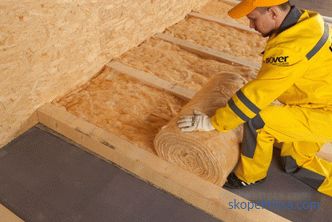
On our site you can find contacts of construction companies that offer roof repair services . You can directly communicate with representatives by visiting the low-rise country exhibition.
-
Sound insulation worthy . The loose structure of the material with numerous air gaps reliably absorbs sound waves.
-
High vapor permeability . An important parameter for any thermal insulation. The material does not accumulate moisture in itself, and, therefore, the thermal conductivity of the layer does not increase and the thermal insulation of residential premises is not disturbed. The remaining dry material does not create the conditions for the appearance of mold and destruction of the structure.
-
Reinforced water-repellent properties . Some types of thermal insulation are additionally treated with a water-repellent compound (AquaProtect technology).
-
Nonflammable . Isover belongs to the non-combustibility class of NG (maximum resistance), which makes it especially desirable during the construction of wooden buildings. However, installation should be carried out in compliance with the requirements of fire safety (foil insulators are self-extinguishing types).
-
The average density is . Do not exceed 13-14 kg / m 3 . Izover is one of the easiest types of thermal insulation, thanks to which it is successfully used where the roof system is not designed for high loads.
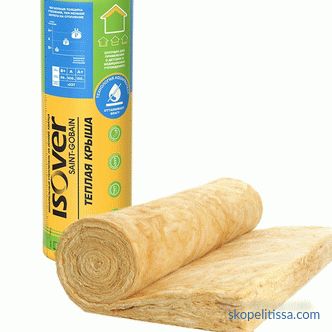
Some drawbacks should be mentioned:
-
Question e Kologichnost and . In general, Izover is safe for humans and the environment, but it should be understood that the binder of the mineral fiber is phenol-formaldehyde resins, in the production of which toxic components are used. These compounds are part of almost all similar heaters, and their emission (evaporation) is regulated by sanitary standards. At the same time, under certain circumstances, fibers can become a source of unhealthy fumes.
-
Problems of installation and use . During assembly work, it is necessary to protect the eyes, the respiratory tract, the skin and the hair, since the smallest fragments of fibers can cause irritation.With internal insulation should take care of the hermetic protection of residential premises.
-
Possibility of waterlogging . In direct contact with water, the material's properties deteriorate: heat loss increases, a moist environment becomes favorable for the appearance of microorganisms. To eliminate an unpleasant situation, the roofing pie should contain a high-quality waterproofing layer.
About roof insulation in the following video:
On our site you can find contacts of construction companies that offer the service installation of roof windows You can directly communicate with representatives by visiting the low-rise country exhibition.
Varieties and advantages
The manufacturer produces several types of thermal insulation, universal or designed for a specific field of application (as the name implies). Thus, the name "Warm Roof" clearly indicates the scope of use of this species. Since a well-insulated roof retains heat well, the use of Izover for an attic makes it possible to expand the living space. Thanks to modern heat insulating materials, the attic floor has become common in suburban housing construction.
Thermal insulation materials differ in density and stiffness, are available in the form of elastic mats, rolled up and elastic plates. The line includes semi-rigid and rigid plates (with fiberglass reinforcement), as well as high-rigidity plates with a groove-tongue-and-groove joint. For insulation of the roof, universal "Optimal" and "Profi" are offered, as well as the types of "Warm Roof" and "Pitched Roofs and Mansards", with a narrower specialization and a slightly different set of characteristics. Insulation has the following advantages:
-
Convenient for warming large areas .
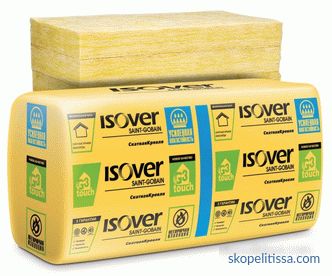
-
Insulation structure has sufficient elasticity in order not to deform and not break, but to regain its shape during installation.
-
Thanks to an improved production technology , the amount of dust decreases during installation (when compared to similar heaters of other manufacturers).
-
The use of roll materials reduces waste to a minimum of .
It may be interesting! In the article on the following link read about the rules for the reconstruction of the attic.
Specifications and prices
The types of roof insulation “Warm Roof” and “Pitched Roofs and Mansards” differ in the form of release, linear dimensions and thermal characteristics, which must be considered when choosing:
-
Warm Roof . Production material - fiber glass. Insulation is sold in the form of rolled-up mats packed in polyethylene; the package may contain 1 or 2 mat. On the packaging there is a marking that facilitates cutting the web into strips of the desired width. The width of the roll is 122 cm, length 4-5 m, thickness 5-15 cm, packing volume 0.6-0.7 m 3 .
On the attic warming in the following video:
-
Pitched roofs and attic ". Basalt fiber insulation; in the package of 10-20 plates. Plate width 61 cm, length 117 cm, thickness 5-10 cm, packing volume 0.71 m 3 .
-
Both heaters are treated using AquaProtect technology, due to which they have a high moisture resistance.
-
Both heaters have the same level of thermal conductivity , sound insulation and flammability.
-
The “warm roof” has a better (lower) level of water absorption and a somewhat lower vapor permeability.
It is important for the owner of suburban housing to ensure a comfortable temperature in the house. Great help in quality insulation can provide Izover for the roof. The price for this insulation in Moscow and the region is as follows:
-
Heater Roof insulation (4000x1220x150 mm, 4.9 m 2 ) : retail 1159-1249 rub. / pack , small wholesale 1125-1200 rubles. / pack
-
Warm Roof Insulator (5000x1220x100 mm, 6.1 m 2 ) : retail 935-996 rub. / pack , small wholesale 911-952 rub. / pack
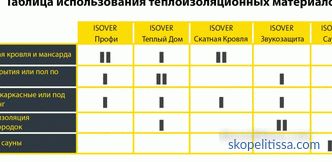
It might be interesting! In the article next Link read about the cascade house Bailer Hill in Washington state.
Conclusion
In the construction of the roof, the warm layer of the “Warm Roof” can be stacked in two ways, depending on the tasks. If the main purpose of the heat insulating layer is sound and heat protection, then the insulation is part of the roofing pie.If you want thermal insulation (in addition to the main function) to prevent the formation of condensate from the inside of the topcoat, then it should be located directly under the outer layer. The required insulation thickness is easily calculated using formulas and tables or, much faster, using an online calculator that contains the required table values.
Rate this article, we tried for you
